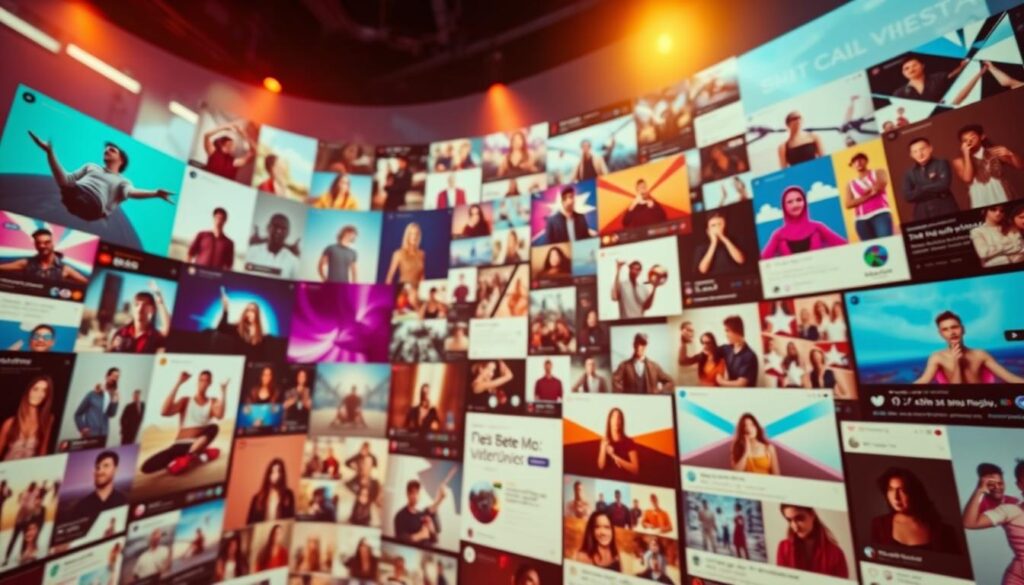“Creativity is intelligence having fun,” said Albert Einstein. This quote perfectly captures the essence of the new era in content creation, where intelligence meets creativity to produce exceptional results. Tools like ChatGPT, Planable, and Canva are transforming how we approach tasks, turning hours of brainstorming into minutes of efficiency1.
These innovations are not just about speed. They’re about crafting messages that resonate deeply with audiences. For instance, posts tailored to specific contexts can boost engagement rates by up to 30%1. This is a game-changer for anyone managing platforms like Instagram and Facebook.
But the real magic lies in the prompts. Well-designed prompts can turn simple ideas into powerful content. They help overcome writer’s block, a challenge faced by 70% of content creators1. With the right tools, you can create posts that not only engage but also drive action.
This article will guide you through actionable tips and examples to elevate your campaigns. Whether you’re a seasoned marketer or just starting, these insights will help you harness the full potential of modern tools.
Key Takeaways
- AI tools like ChatGPT and Canva streamline content creation, saving time and effort.
- Tailored posts can increase engagement rates by up to 30%.
- Effective prompts help overcome writer’s block, a common challenge for 70% of creators.
- Clear calls to action can improve click-through rates by 20%.
- Incorporating brand tone in content boosts brand recall by 25%.
Understanding AI Prompts for Social Media Advertising Campaigns

In today’s fast-paced digital landscape, precision in communication is key. Intelligent tools have become essential for crafting messages that resonate with your target audience. These tools rely on well-designed prompts to generate content that aligns with your goals.
Defining AI Prompts in Modern Marketing
An AI prompt is a specific instruction or question that guides an intelligent tool to produce desired content. For example, asking for a rewritten draft or alternative ideas can yield fresh perspectives. This approach helps marketers overcome creative blocks, a challenge faced by 70% of content creators2.
Providing context is crucial. When prompts include details like tone, style, and audience preferences, the output becomes more relevant and accurate2. This specificity ensures that your social media post aligns with your brand’s voice and strategy.
The Role of AI in Content Ideation
Intelligent tools can generate multiple versions of a single post, saving time and effort. This is particularly useful when refining drafts or testing different approaches. Campaigns that incorporate these tools have seen a 30% increase in engagement rates3.
These tools also assist in tailoring content for different platforms. For instance, a 280-character post for Twitter requires a different approach than a 140-character update for LinkedIn. By leveraging these capabilities, marketers can create engaging content that speaks directly to their target audience.
Ultimately, well-crafted prompts are the foundation of effective social media marketing. They ensure that your content is not only relevant but also drives meaningful interactions. To learn more about boosting engagement, check out this guide.
The Evolution of Social Media Marketing with AI

The way we approach marketing has undergone a dramatic transformation. Gone are the days of lengthy brainstorming sessions and manual content creation. Today, innovative tools have streamlined the process, making it faster and more efficient4.
In the past, creating a single post required hours of effort. Teams would gather to brainstorm ideas, draft content, and refine it multiple times. Now, advanced tools can generate multiple versions of a post in minutes, saving valuable time4.
From Manual Brainstorming to Automated Creativity
Traditional methods often led to creative blocks. Teams struggled to come up with fresh ideas consistently. With modern tools, generating new concepts has become effortless. For example, rephrasing content to better resonate with audiences is now a simple task4.
These tools also ensure consistency across platforms. A well-crafted post for Instagram can be adapted for LinkedIn or Twitter without losing its essence. This adaptability has become a game-changer in media marketing5.
Businesses are increasingly relying on these tools to stay competitive. Over 57% of companies planned to boost their investments in this area in 20234. This trend highlights the growing importance of automation in creating engaging content.
As the landscape evolves, so do the strategies. The shift from manual to automated processes has not only improved efficiency but also enhanced the quality of posts. This evolution marks a new era in marketing, where creativity meets technology.
How AI Enhances Content Creation for Social Media

Creativity meets efficiency in the modern era of digital marketing. With advanced tools, generating fresh and engaging ideas has never been easier. These tools not only save time but also ensure that your content resonates with your audience6.
Generating New and Engaging Ideas
One of the biggest challenges in marketing is coming up with fresh ideas consistently. Tools that offer prompt help can spark creativity by suggesting unique angles and themes. For example, they can rewrite drafts or generate multiple versions of a post in seconds4.
These tools also analyze audience behavior to recommend topics that are likely to engage. Over 85% of marketers plan to use such tools for generating ad copy from scratch in 20247. This ensures a steady flow of impactful social media content.
Overcoming Creative Blocks
Creative blocks can slow down even the most experienced marketers. Automated suggestions from these tools can provide the inspiration needed to move forward. For instance, they can rephrase content or suggest new formats like videos, which 44% of consumers prefer7.
By leveraging these capabilities, marketers can maintain a consistent and engaging presence. The result is a streamlined process that keeps content fresh and relevant6.
Crafting Effective AI Prompts for Social Media Advertising

Crafting impactful messages starts with the right instructions. A well-designed prompt ensures that your media post aligns with your goals and resonates with your audience. Clear and specific instructions are the backbone of successful content creation8.
Key Components of a Successful Prompt
Every effective prompt includes clarity, context, and actionable instructions. For instance, specifying the tone and style helps the tool generate content that matches your brand voice8. Providing examples can also guide the tool to produce more relevant output.
Real-life examples, like those from Planable, show how detailed prompts lead to better results. Including parameters such as audience preferences and format guidelines ensures the output is tailored to your needs9.
Consistency is key. A prompt that reflects your brand identity helps maintain a unified voice across all platforms. This approach not only enhances engagement but also strengthens brand recall8.
Balancing detail is crucial. While specific instructions improve output quality, overwhelming the tool with too much information can hinder its effectiveness. Focus on essential elements like tone, context, and limitations5.
By following these guidelines, you can create prompts that drive meaningful interactions. Whether you’re drafting a media post or refining a campaign, the right instructions make all the difference.
Structuring AI Prompts: Tips & Best Practices

Creating effective content starts with a well-structured approach. Clear instructions and thoughtful planning are essential for guiding tools to produce results that align with your goals. Whether you’re crafting a post idea for Facebook or Instagram, the right structure ensures consistency and relevance10.
Providing Clear Context and Specific Instructions
Context is key to generating accurate and relevant content. When creating a prompt social media, include details like tone, audience, and purpose. For example, specifying a casual tone for Instagram or a professional tone for LinkedIn ensures the output matches your brand’s voice11.
Clear instructions also reduce the need for revisions. Break down complex requests into smaller, actionable steps. This approach increases response accuracy by up to 50%11. Providing examples or templates can further clarify your expectations.
Setting Limitations and Format Guidelines
Every platform has unique requirements. For instance, Facebook posts often perform better with concise text and eye-catching visuals. Instagram, on the other hand, thrives on engaging captions and high-quality images10.
Setting limitations, such as character counts or word restrictions, ensures your content fits the platform’s format. This practice leads to a 30% increase in satisfaction with the output11. By tailoring your prompts to these guidelines, you save time and improve efficiency.
These best practices not only streamline the process but also lead to consistent and reliable content. Whether you’re managing multiple platforms or focusing on a single channel, structured prompts are the foundation of success.
Platform-Specific Strategies for AI-Generated Content

Each platform has its own unique rhythm and audience expectations. To maximize engagement, your approach must adapt to these differences. Tailoring your strategy ensures your content resonates with the right audience on the right platform.
Tailoring Prompts for Facebook & Instagram
Facebook thrives on community-driven content. Use prompts that encourage interaction, such as questions or polls. For example, “What’s your favorite summer memory?” can spark conversations12.
Instagram, on the other hand, is visually driven. Focus on prompts that highlight high-quality images or short video clips. A prompt like “Share a behind-the-scenes look at your day” works well for Stories6.
Optimizing for LinkedIn & Twitter
LinkedIn demands professionalism. Use prompts that highlight expertise or industry insights. For instance, “What’s the biggest trend in your field this year?” aligns with its audience12.
Twitter values brevity and timeliness. Craft prompts that fit within its character limit while being impactful. A prompt like “Share your top tip for productivity in 280 characters” is ideal6.
Testing and iterating your prompts is crucial. Analyze engagement metrics to refine your approach for each platform. This ensures your content remains relevant and effective12.
Leveraging Audience Data to Refine Your Prompts

Understanding your audience is the foundation of impactful content. When you know what resonates with your target audience, you can craft messages that truly engage. This approach not only boosts interaction but also strengthens your brand’s connection with its followers5.
Collecting and analyzing data is the first step. Tools like surveys, analytics platforms, and social listening can provide valuable insights. For example, analyzing engagement metrics helps identify what content performs best13.
Understanding Target Audience Needs
To insert target audience insights into your prompts, start by identifying their preferences. What topics do they care about? What tone resonates with them? These details ensure your content aligns with their expectations14.
Case studies show that personalized content drives higher engagement. For instance, brands that tailor their messages based on audience data see a 30% increase in interaction rates5. This highlights the importance of refining prompts to meet specific needs.
Continuous improvement is key. Regularly review performance data to adjust your strategy. This iterative process ensures your content remains relevant and effective13.
Real-World Success: AI in Social Media Advertising

Real-world examples highlight the transformative power of modern tools. Brands are achieving remarkable results by integrating innovative strategies into their campaigns. Let’s explore two standout case studies that demonstrate this impact.
Heinz’s “Draw Ketchup” Campaign
Heinz launched the “Draw Ketchup” campaign, inviting users to create their own ketchup bottle designs using DALL-E 2. This creative event generated over 850 million impressions worldwide15. The campaign’s success lies in its ability to engage audiences through interactive storytelling.
By leveraging advanced tools, Heinz turned a simple product into a global sensation. The campaign’s results highlight the importance of creativity in driving engagement16.
Canva’s Magic Studio Impact
Canva’s Magic Studio has revolutionized design creation. This tool enables users to generate eye-catching visuals in seconds, boosting engagement rates by up to 20%15. Its intuitive features make it a favorite among marketers and designers alike.
For example, Magic Studio’s ability to create consistent branding across platforms has made it a go-to solution for businesses. Its impact on story-driven content is particularly noteworthy16.
These examples illustrate how modern tools can elevate campaigns. Whether it’s a viral event or a design platform, the key lies in aligning tools with audience needs. The results speak for themselves.
Navigating Challenges and Limitations with AI Prompts

While modern tools offer incredible efficiency, they come with their own set of challenges. Understanding these pitfalls is crucial for creating effective content in media marketing.
One common issue is maintaining the right tone. Automated tools may not always capture the nuances of your brand’s voice. For example, a tweet might sound too formal or too casual, missing the mark with your audience17.
Another limitation is format. Tools can sometimes generate outputs that don’t fit platform requirements. A tweet might exceed the character limit, requiring manual adjustments18.
To catch these mistakes, always review the output. Double-check for tone, format, and relevance. This step ensures your content aligns with your goals19.
Setting clear guidelines is also essential. Specify character limits, tone, and style in your prompts. This reduces the need for revisions and improves accuracy17.
Finally, never skip the manual review. Even the best tools can’t replace human judgment. Take the time to insert target audience insights and refine the content18.
By addressing these challenges, you can maximize the potential of modern tools. A thoughtful approach ensures your content resonates and drives meaningful engagement.
Integrating AI Prompts into a Dynamic Content Calendar

Efficiency meets creativity in modern content planning. A well-structured calendar ensures consistent engagement while adapting to emerging trends. By integrating advanced tools, you can streamline your strategy and focus on delivering impactful content.
Scheduling for Consistency and Engagement
Consistency is key to maintaining audience interest. Tools that offer prompt help can generate a 30-day schedule in minutes, saving valuable time20. This approach ensures your post frequency aligns with audience expectations, boosting interaction rates by up to 30%21.
Using scheduling tools with advanced capabilities can optimize posting times based on audience activity. This increases reach by 20-30%20. By planning ahead, you can focus on refining your strategy rather than last-minute content creation.
Adapting Prompts to Emerging Trends
Trends evolve quickly, and your content must keep pace. Advanced tools can predict trends and identify gaps in your calendar22. For example, incorporating a timely poll or themed post can spark engagement and make your brand relatable21.
Flexibility is essential. Regularly review analytics to adjust your prompts and ensure relevance. This iterative process can improve performance metrics by 10-20%20. By staying adaptable, you can maintain a dynamic and engaging presence.
Using AI for Product Launches and Special Campaigns
Launching a new product or running a special campaign requires precision and creativity. Modern tools can streamline this process, ensuring your message resonates with your audience. By leveraging these capabilities, you can create buzz and drive engagement effectively23.
One key advantage is the ability to generate tailored ad copies quickly. For example, tools can draft multiple versions of an announcement post in seconds. This saves time and allows you to focus on refining the message rather than starting from scratch24.
Incorporating event details into your content is another powerful strategy. Whether it’s a launch party or a limited-time offer, these tools can help craft engaging posts that highlight the excitement. This approach ensures your audience stays informed and interested23.
Rapid content creation is a game-changer during campaigns. When you need to adjust your messaging on the fly, these tools provide the flexibility to do so. This adaptability can make a significant difference in the success of your campaign24.
Aligning your product messaging with audience expectations is crucial. Use insights from data to tailor your content. Personalized messages can increase customer satisfaction and loyalty, driving better results23.
By integrating these strategies, you can maximize the impact of your tool during product launches and special campaigns. The result is a seamless, engaging experience for your audience.
Advanced Customization Techniques for AI Output
Tailoring content to perfection requires advanced techniques. By experimenting with multiple versions and testing variations, you can ensure your media posts resonate with your audience. This approach not only enhances engagement but also drives meaningful action.
Experimenting with Multiple Versions
Creating multiple versions of a single tweet or post allows you to test different angles. For example, one version might focus on humor, while another highlights a call to action. This strategy helps identify what works best for your audience25.
Tools like Typeface make it easy to generate these variations quickly. By inserting specific prompts, you can produce tailored content that aligns with your brand’s voice26. This saves time and ensures consistency across platforms.
A/B Testing for Optimal Performance
A/B testing is a powerful way to refine your prompts social media strategy. By comparing two versions of a post, you can determine which one performs better. For instance, testing different headlines for a tweet can improve click-through rates by 10-20%27.
Integrating feedback from these tests allows you to iterate rapidly. This iterative process ensures your content remains relevant and impactful26. For more tips on optimizing your workflow, check out this guide.
By leveraging these advanced techniques, you can maximize the effectiveness of your content. The result is a dynamic strategy that keeps your audience engaged and drives results.
Conclusion
Transforming how we connect online starts with innovative strategies. From crafting engaging posts to scheduling content efficiently, modern tools have reshaped the landscape. These advancements allow you to create impactful messages that resonate with your audience28.
Platform-specific approaches ensure your social media presence aligns with audience expectations. For instance, tailoring posts for Instagram or LinkedIn can boost engagement by up to 30%29. Testing and refining your ideas is key to staying relevant.
Real-world examples, like Heinz’s viral campaign, show the power of creativity. By leveraging these tools, you can create content that drives results. Continuous optimization ensures your strategy evolves with trends.
Ready to elevate your approach? Start applying these techniques today and share your success stories. Together, we can push the boundaries of what’s possible in social media.
FAQ
What are AI prompts in modern marketing?
How does AI assist in content ideation for social media?
What’s the difference between manual brainstorming and AI-driven creativity?
How can AI help overcome creative blocks in content creation?
What are the key components of a successful AI prompt?
How do I tailor AI prompts for platforms like Facebook and Instagram?
Why is understanding the target audience crucial for AI prompts?
Can you share an example of a successful AI-driven campaign?
What challenges might I face when using AI prompts?
How can I integrate AI prompts into a content calendar?
What’s the best way to use AI for product launches?
How can I customize AI outputs for better results?
Source Links
- Creative AI prompts for social media managers | HeyOrca
- How to Craft AI Prompts for Social Media Posts + 50 AI Prompts to Try in 2025
- AI Prompts for Social Media
- Crafting Compelling Social Media Content and Campaigns with AI Tools
- 26 ChatGPT Prompts for Social Media Marketing to Create Compelling Content
- How to adopt AI for content marketing
- 14 No-Brainer Ways to Use AI for Social Media | WordStream
- Prompt crafting
- 20 AI Prompt Examples to Jumpstart Your AI-Powered Digital Marketing
- 20 Completely Awesome ChatGPT Prompts for Marketing | WordStream
- How To Create ChatGPT Prompts
- How to Use AI in Social Media to Drive Business Growth
- AI in Paid Social: Leveraging AI for Your Campaigns | NoGood
- 40 Actionable Social Media Prompts for Marketers [+Examples] | Sprinklr
- AI Social Media Management
- AI for Social Marketing: Top Tools & Examples for 2024
- 40 AI prompts to boost your marketing team’s creativity and efficiency – Work Life by Atlassian
- Best Practices: Use ChatGPT Prompts to Elevate Your Marketing
- Everything You Need to Know About AI Marketing + 75 AI Prompts
- How to Create a Content Calendar with ChatGPT
- 26 Copy & Paste AI Prompts for Social Media | LocaliQ
- 10 Best AI Content Calendar Generators for 2025 Planning |
- 25+ AI prompts for Marketing in 2025
- How to Use AI to Accomplish Common Marketing & Communication Tasks (With Prompt Ideas) – Stukent
- 5 Advanced AI Prompts for Marketing | How to
- Top AI & ChatGPT Prompts for Social Media Post Generation
- Advanced AI Prompt Optimization for 2024
- 50+ Prompts To Generate Social Media Content With AI
- 100+ ChatGPT Prompts for Social Media in 2025







